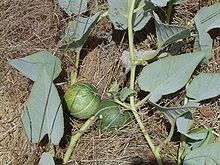- Cucurbita foetidissima
-
Cucurbita foetidissima 
Buffalo gourds in Puente Hills Scientific classification Kingdom: Plantae (unranked): Angiosperms (unranked): Eudicots (unranked): Rosids Order: Cucurbitales Family: Cucurbitaceae Genus: Cucurbita Species: C. foetidissima Binomial name Cucurbita foetidissima Cucurbita foetidissima (buffalo gourd, calabazilla, chilicote, coyote gourd, fetid gourd, Missouri gourd, stinking gourd, wild gourd, wild pumpkin) is a xerophytic tuberous plant found in the southwestern USA and northwestern Mexico. A member of the cucumber family, the fruit is consumed by humans and animals. The fruit is eaten cooked like a squash when very young. As the fruit becomes fully mature, it is too bitter for humans to eat. When the fruit is mature -- a stage marked by increasing desiccation of vine, leaves, fruit-stem, and fruit itself -- it begins its final gourd stage (see Notes below). It grows fast, requiring little water, including an often massive underground tuber that has been the object of proposals to grow the plant for fuel[1] or biofuel such as ethanol[2].
-
Staminate (male) flower
References
- ^ Smeal, D. (1997). "Carbohydrate biofuels. III. Consumptive-use and root yield of buffalo gourd (Cucurbita foetidissima HBK)". Fuel and Energy Abstracts 38 (5): 325. doi:10.1016/S0140-6701(97)81177-0. http://www.ingentaconnect.com/content/els/01406701/1997/00000038/00000005/art81177;jsessionid=2cm9cfbwhaukl.alexandra. Retrieved 2008-08-22.
- ^ Blume, David (2007). Alcohol Can Be a Gas! Fueling an Ethanol Revolution for the 21st Century. The International Institute For Ecological Agriculture.
Notes
- The gourd of C. foetidissima, like the fruit most species of the genus, within five to eight months becomes lighter by drying, assisted by various molds on its surface that subsist partly on the moisture extracted from the fruit's rind. The interior filaments that support the seeds also dry out and in most gourds release the seeds, which may rattle when the gourd is agitated. The seeds often remain viable for months or even years within an undamaged gourd. Various insects may penetrate the hard skin, although the external molds appear to prevent damage by most insects, so the skin may become hard enough to take a polish. White molds seem to result in smooth surface areas and black molds often form circular patterns. The hardened rind or "shell" of individual varieties may be thin and brittle or quite thick and durable.

This Cucurbitales article is a stub. You can help Wikipedia by expanding it. -




